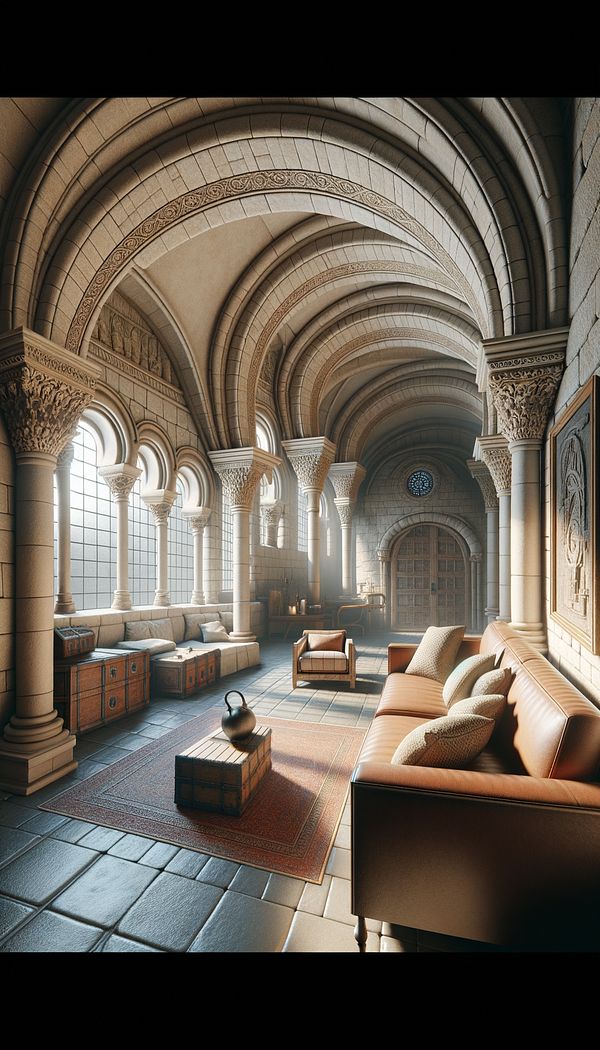What is Romanesque?
Romanesque is a style of architecture and design characterized by semi-circular arches, thick walls, and sturdy pillars.
Description
Romanesque, as a style of architecture and design, flourished between the 10th and 12th centuries, notably in Europe. It represents a period where architecture began transitioning from the classical forms of the ancient world into what would eventually become the more vertical, light-filled spaces of the Gothic style. Romanesque designs are marked by their heavy, robust appearance, featuring semi-circular arches, thick walls, large towers, and sturdy pillars. These elements not only conveyed a sense of solidity and security but also allowed for the creation of expansive, vaulted interiors.
It’s important to understand that the application of Romanesque design extends beyond just architecture. In terms of interior design, this style also influences room layouts, furniture, and decorative elements, reflecting the period's emphasis on sturdiness, functional form, and religious symbolism. Fabrics often feature medieval motifs and are in rich, dark hues, complementing the overall theme of the interior space. Moreover, Romanesque-inspired design often incorporates features like rounded archways, intricate stone carvings, and detailed mosaics, driving home the effect of medieval elegance and grandeur.
Today, integrating Romanesque elements into modern spaces can offer a timeless, classic appeal, blending historical aesthetics with contemporary functionality. Although adapting a full Romanesque style in a modern home might be challenging due to its distinct architectural requirements, incorporating specific design elements or motifs can contribute significantly to creating a unique, historically-inspired environment.
Usage
In contemporary interior design, Romanesque elements might be integrated through the use of rounded archways in doorways or windows, wall murals depicting medieval scenes, or furniture that mimics the robust, ornate qualities typical of the period. Accessories like candle holders, tapestries, and ornate rugs can also add a touch of Romanesque flair to modern homes.
FAQs
-
Can Romanesque style be incorporated into modern homes?
Yes, Romanesque style can be integrated into modern homes by adopting specific elements such as rounded archways, medieval-themed murals, and robust furniture reminiscent of the era. Accessory choices like tapestries and ornate rugs further enhance the Romanesque appeal.
-
What distinguishes Romanesque design from Gothic design?
Romanesque design is distinguished from Gothic design by its use of semi-circular arches, thick walls, and heavy, robust appearance. Gothic design, on the other hand, features pointed arches, flying buttresses, and an overall more vertical, light-filled aesthetic.
-
Are there specific colors associated with Romanesque interior design?
Yes, Romanesque interior design often features rich, dark hues complementing its emphasis on sturdiness, function, and medieval motifs. These colors help create a warm, intimate space reflecting the period's architectural and decorative styles.
Practical Application
To incorporate Romanesque touches into your home, focus on integrating architectural and decorative elements that highlight medieval elegance. Consider adding rounded archways, durable and ornate furniture, and wall decorations featuring medieval themes. Incorporating fabrics in rich, dark colors and adding Medieval-inspired accessories can also contribute to achieving a Romanesque aesthetic in a modern space.
-
Architectural Elements199 articles
-
Design Styles478 articles
-
Furniture Types599 articles
-
Decorative Techniques322 articles
-
Wall Treatments & Finishes157 articles
-
Claw & BallClaw & Ball is a decorative motif featuring a claw, paw, or talon grasping a ball, typically used in furniture legs.
-
Contrasting WeltContrasting welt is a decorative edge detail used in upholstery and soft furnishings.
-
CamelbackA camelback is a high, rising curve on a piece of furniture that resembles the shape of a camel's hump.
-
Slat BackSlat back is a design feature characterized by vertical slats placed on the backrest of chairs or other furniture.
-
Bonheur-du-jourA small, elegant writing desk with a variety of compartments.
